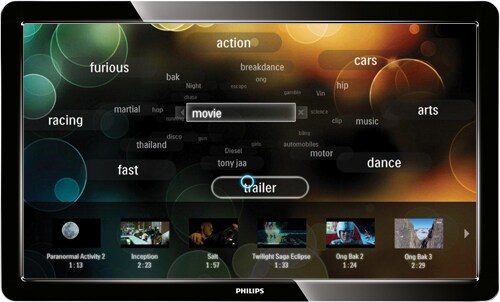uWand Direct Pointing Control
Intuitive control for smart devices
uWand Direct Pointing Control
Intuitive control for smart devices
uWand Direct Pointing Control for Smart TV and Smart Home uWand is an intuitive camera based direct pointing and gesture control technology for Smart TV’s and Smart Home applications from Philips. The technology can be embedded in remote controls giving users fluid and accurate direct control. With uWand the remote control turns into an intuitive hybrid controller. It maintains the core, recreational, lean back experience while enabling new Smart TV and Smart Home use cases such as gaming, browsing online video and operating lamps, blinds etc.

Smart TV

TV brands and operators, through their settop box, are increasingly offering "Smart TV services" which requires a higher degree of user interaction. Where advances in user interface (UI) design made personal computing accessible, few in the industry have focussed the same attention on the need for a more sophisticated and intuitive UI. The remote control is fundamental to the UI and yet most SmartTV consumers are still asked to navigate and interact with a range of services using the up / down / left / right functionality of traditional remotes. That needs to change. In the world of Smart TV a graphical UI is a given but we can’t expect button-based remotes to be the hardware interface to that UI, the level of interaction required is beyond the basic design capabilities.

We also can’t expect to use PC hardware interfaces for Smart TV – the mouse, a relative pointing device, doesn’t work and consumers are not going to move from their seats to operate a touch screen or waves their arms or body until they’re tired. It’s time for a new approach. uWand’s direct pointing technology is designed specifically for use with SmartTV. It delivers the same kind of interaction and intuitive operation of touch screen devices but from the comfort of the sofa. uWand, the future of remote control
Choose direct, choose uWand

SmartTVs now require a multi-faceted user interface (UI), akin to PCs and tablets. These are largely driven by pointing-based interfaces, so it is no surprise that similar interfaces are now being adopted by designers and manufacturers of SmartTVs and set-top boxes. Unfortunately, the established PC and tablet interfaces (mouse, touchpad and touch screen) don’t work well in a living room environment when the user is sitting a meter or more from the screen.
SmartTV remote control devices require a different approach – pointing, one of the first gestures we learn to make. There is a choice between relative and direct pointing: The animation below provides a simple demonstration of gyro and uWand based remotes in action and illustrates the disconnected user experience of relative pointing remotes. To see how that works in action try our SmartTV game simulation. Consumers never give you a second chance to make a first impression.
Smart home

uWand technology enables a dramatic simplification of Smart Home interaction by providing users with a single remote for intuitive control of multiple smart devices. Selection of the target device is done by pointing uWand to the target device and control is achieved via gestures or limited button presses – the room itself becomes part of the user interface. Controlling the smart home with uWand is extremely easy. The camera embedded in the remote can quickly identify at which device the user is aiming. uWand technology is designed to provide consumers with the easiest and most intuitive interface for controlling smart home devices. With a single uWand-equipped remote control in the living room, it is possible to adjust the air conditioning, dim the lights, open the curtains and even play complex games on the smart TV, all through a single device.
The additional benefit of uWand: there is no programming required, and the commands can be intuitive gestures or based on the press of a button. This could be a swipe to open the curtains or a twist of the wrist to turn up the heat.
Technology to revolutionize the living room

Philips’ uWand technology, a complete firmware solution, incorporates two primary elements: The concept is extremely simple:
Downloads
uWand Brochure
uWand Back Ground Information
White Paper
White Paper



